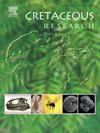酒泉盆地下白垩统孢粉植物及其古气候意义
IF 1.7
3区 地球科学
Q1 GEOLOGY
引用次数: 0
摘要
甘肃酒泉盆地下白垩统新民堡群是重要的烃源岩。从地层中发现了许多化石,如早期被子植物、昆虫、鸟类等。因此,新民堡群是白垩纪研究的热点之一。然而,以往的研究大多集中在露头剖面和地层上部。本文主要研究了新民堡群下部钻孔孢粉学。结果表明,石竹属植物的含量呈波动上升趋势,最高可达90%。结合前人的研究,提出酒泉盆地早白垩世的气候变化涉及两个旋回,每个旋回都表现出由暖湿向干热的变化趋势。将池金堡组中上段的classopolis高含量带与前oae1a进行了比较。池金堡组孢粉组合的变化揭示了前OAE1a - OAE1a的古气候。本文章由计算机程序翻译,如有差异,请以英文原文为准。
The palynoflora from the Lower Cretaceous of Jiuquan Basin, Gansu Province, NW China, and its paleoclimate implication
The Lower Cretaceous Xinminpu Group in the Jiuquan Basin of Gansu Province is an important source rock. Many fossils have been found from the strata, such as early angiosperms, insects, birds and so on. So the Xinminpu Group is one of the hotspots in Cretaceous research. However, most previous studies focused on the outcrop sections and the upper part of the stratum. This paper mainly deals with the palynology of the lower part of the Xinminpu Group in boreholes. It is found that the content of the genus Classopollis (Cheirolepidiaceae) increases in a fluctuating manner upwards, reaching a maximum of 90 %. Considering the previous research, it is proposed that the climate change in the Jiuquan Basin during the Early Cretaceous involves two cycles, and each cycle showed a trend from warm and humid to dry and hot. The high - content zone of Classopollis in the middle - upper part of the Chijinpu Formation is compared with pre -OAE1a. The changes in the palynological assemblage of the Chijinpu Formation reveal the paleoclimate from pre - OAE1a to OAE1a.
求助全文
通过发布文献求助,成功后即可免费获取论文全文。
去求助
来源期刊

Cretaceous Research
地学-地质学
CiteScore
4.10
自引率
19.00%
发文量
235
审稿时长
12 weeks
期刊介绍:
Cretaceous Research provides a forum for the rapid publication of research on all aspects of the Cretaceous Period, including its boundaries with the Jurassic and Palaeogene. Authoritative papers reporting detailed investigations of Cretaceous stratigraphy and palaeontology, studies of regional geology, and reviews of recently published books are complemented by short communications of significant new findings.
Papers submitted to Cretaceous Research should place the research in a broad context, with emphasis placed towards our better understanding of the Cretaceous, that are therefore of interest to the diverse, international readership of the journal. Full length papers that focus solely on a local theme or area will not be accepted for publication; authors of short communications are encouraged to discuss how their findings are of relevance to the Cretaceous on a broad scale.
Research Areas include:
• Regional geology
• Stratigraphy and palaeontology
• Palaeobiology
• Palaeobiogeography
• Palaeoceanography
• Palaeoclimatology
• Evolutionary Palaeoecology
• Geochronology
• Global events.
 求助内容:
求助内容: 应助结果提醒方式:
应助结果提醒方式:


